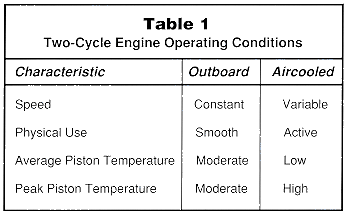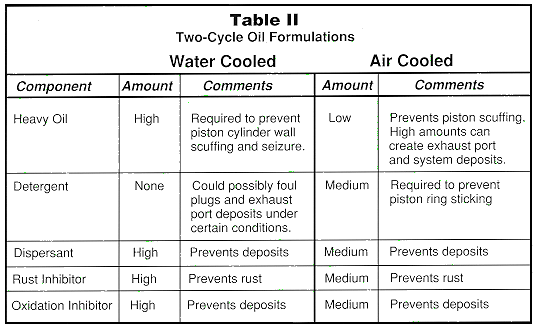
Choosing an Oil for Two-cycle Engines

There are several oils out there for an ultralight pilot to select
from, and everybody has their favorite. Others are confused about
claims as to which one they should use and why. How about oil injected
versus the common fuel and oil pre-mix? What's the difference between an oil
formulated for water cooled and an oil made for air cooled engines? The
chart in Table 1 shows the general operating conditions of each type of
engine.

To understand how two-cycle oils work in your engine, we need to cover
some basic training on engine operating conditions and oil formulation.
Outboard engines are characterized by their constant speed, high output
operation. They are usually set at a desired high speed and continue at
that speed until the destination is reached and then throttled down.
Also, they are constantly cooled with fresh, cool, non recirculated
water. Chain saws, on the other hand, are a high action operation. They
are constantly started and stopped, used for short periods, and frequent
overloads are its hard place in life. Additionally, they have smaller
displacements than outboards and are air cooled. By understanding how
the operation of an engine can affect the oil used and how an oil can
affect the engine, we can better appreciate the difference between a
water cooled two-cycle oil and one formulated for an air cooled two-cycle
engine. The components used in these two oils, and reasons for their use
are shown in Table 2.

Water cooled two-cycle engine oils require higher levels of a heavy oil
to prevent piston and cylinder wall scuffing. Because of their high
average piston temperature, lighter oils evaporate too quickly from the
piston cylinder contact area. The heavy base oil, which vaporizes at
very high temperatures, resists evaporation and remains in place to
provide lubrication to the piston and cylinder. Air cooled oil
formulations must have much lower levels of the heavy base oil than water
cooled engine oils. These oils require only a small amount of heavy oil
to provide protection against piston scuffing and seizure at peak
temperatures. High levels of heavy base oils in an oil formulated for
air cooled engines can cause engine deposits. These deposits form as a
result of incomplete burning of the heavy oil. The deposits can cause
piston ring sticking and can eventually plug or disrupt the flow of the
exhaust system, resulting in power loss and possible engine damage.
Detergent additives should not be used in water cooled two-cycle oil
formulations. When burned with the fuel, detergents produce an ash
deposit in the cylinders. This ash deposit can possibly foul spark
plugs., form exhaust port deposits which cause loss of power, and
possibly create cylinder hot spots that can cause destructive
pre-ignition. On the other hand, the only way to protect air cooled
two-cycle engines against piston ring sticking at their high peak
temperatures is to include some detergent additives in the oil
formulation. Detergents provide high temperature deposit control not
available from other additives used in the oil. However, in the air
cooled engine, any ash deposits that could form from the detergents are
dislodged by engine vibration and exhausted from the engine.
Now is a good time for a lesson on ash. Ash is the non-combustible
residue of a lubrication oil or fuel. Detergent additives contain
metallic derivatives, such as calcium, barium and magnesium sulfonates
that are common sources of ash. Ash deposits can impair engine
efficiency and power. But, detergents are an important component of
engine oil that help control varnish deposits, piston ring deposits, and
rust (yes, rust) by keeping insoluble combustion particles from adhering
to metal surfaces. in some cases, detergents neutralize acids formed
from combustion of the fuel mixture. Ash deposits may have a grayish
color, where carbon residue is usually black and sooty.
Carbon residue, on the other hand, is different from ash. Carbon residue
is formed from unburned and partially burned fuel, and from burning of
the crankcase lubricant. Water from condensation of combustion products
along with carbon residue from fuel contribute to engine piston deposits.
Carbon deposits are normally black and have a sooty appearance.
Oils formulated for outboard engines require a large amount of
antioxidant and dispersant additives to control deposit formation since
these oils do not contain detergents. outboard oils also contain a large
amount of rust inhibitors because an outboard engine's continuous contact
with water makes rust prevention an important requirement. Air cooled
oils contain lower amounts of antioxidants and dispersants, since the
detergent additives do most of the work of preventing deposit
accumulation. These oils also contain rust inhibitor additives to
protect against rust that can form from water that enters the engine due
to condensation.
So how do some oils claim to be multi-purpose or formulated for water and
air cooled engines? These oils have usually been formulated to meet the
National Marine Manufacturers Association (NMMA) TC-WII(tm) or TC-W3(tm)
specification. These specifications require the oils to be tested under
rigorous test conditions. An air cooled engine test is part of these
requirements. Therefore, a manufacturer can claim multi-purpose
applications. Although these oils have been tested in an air cooled
engine and will lubricate an air cooled engine, an oil formulated
specifically for air cooled engine use may be the best choice for your
engine.
Just what oil does Rotax recommend for their two-cycle engines? Rotax
recommends using an oil meeting American petroleum Institute (API)
Service Classification TC. API TC is a designation for high performance
two-cycle engines (typically 50cc to 500cc), excluding outboard engines.
This performance rating is determined by engine tests that evaluate (1)
anti-scuff characteristics, (2) piston ring sticking and engine
cleanliness, and (3) preignition. in the TC category, a 50cc and a 350cc
Yamaha engine are used to evaluate the oil.
Rotax engines that require the fuel and oil to be premixed should use a
2% (50:1) concentration of oil in the fuel. It is very important that
the fuel/oil mix is correct. in other words, don't add too much or too
little oil to the fuel. If a little does good, more oil added to the
fuel doesn't necessarily do better. in fact, too much oil will lead to
excessive deposits and could also cause exhaust smoke and spark plug
fouling. not enough oil can lead to piston skirt and cylinder wall
scuffing and eventual engine damage.
Gasoline containing alcohol (ethanol and/or methanol) should not be used
unless permitted by the engine manufacturer. Alcohol containing fuels
can absorb water and separate from the gasoline. Additionally, the
alcohol may not be compatible with some fuel system components, such as
plastic and rubber compounds.
Rotax also recommends de-carboning the engine after 50 hours of
operation. This procedure is designed to remove excessive piston
deposits and to check for possible stuck piston rings. Rotax allows up
to 0.040 in. of soot and carbon buildup on the piston crown before
removal of the carbon is required.
Not only does Rotax recommend an API TC oil for the 277 through the 503
air-cooled engines, but also for the 532 and 582 water-cooled engines.
These 532 and 582 engines run at internal temperatures similar to the air
cooled Rotax engines, as evidenced by their use of the same spark plug.
Special precautions should be taken when switching oils, even between the
same brands. Because of the special formulation of air cooled engine
oil, these oils generally are not compatible with water cooled engine
oils. Caution should be exercised to ensure that these products are not
mixed together. Special precautions should be taken when changing from a
product designed primarily for water cooled engines to an air cooled
product, particularly in oil injection systems where the undiluted oils
would be mixed together. It is recommended that the oil reservoir and
lines be drained when changing to another formulation. In applications
where the oil is premixed with the fuel, it is recommended that the fuel
tank(s) be drained and fuel filters changed.
Now, who makes an oil that has been formulated to meet these requirements
and is readily available? Every ultralight pilot in this area I know has
switched to the Pennzoil 2-Cycle Oil for Air Cooled Engines and has had
good luck for the past three years using it. Teardowns of engines for
overhauls and general maintenance have indicated very little wear and
even the fine crosshatch hone marks are still intact on our engines.
Articles in ultralight and other flying magazines indicate that this is
the oil of choice in experimental applications as well as the true
ultralight all across the country. Need an added benefit? Pennzoil is
usually a lot cheaper in price and comes in 16-ounce plastic bottles.
According to engineers at Pennzoil, this product contains a unique
combination of detergents and ash-free dispersants to protect against
high temperature piston ring sticking, spark plug fouling and port
plugging. It also protects against rust and corrosion, plus has
anti-wear protection for high RPM needle roller bearings. I don't know
of any other major refinery other than Pennzoil that makes an oil that
they actually recommend for use in ultralights. Try it; you'll like
it.
Reprinted with permission of E.A.A. Experimenter(tm) Magazine, April,
1994. Article submitted by Charles Kudolis (EAA 299878)
- Note:
- Pennzoil uses this article as an advertising brochure. The last
paragraph is a lot like an advertisement, but I thought the article
in general was quite informative. I am not advocating the
use of Pennzoil, nor is this an advertisement for them. This
article is quite relevant wether or not you decide to use Pennzoil.
Any spelling or grammar mistakes are mine. If you see anything
wrong, please let me know.
--Jon
 Back to the Ultralight home page
Back to the Ultralight home page
 Jon N. Steiger / stei0302@cs.fredonia.edu / SUNY College at Fredonia
Jon N. Steiger / stei0302@cs.fredonia.edu / SUNY College at Fredonia
![]()
![]()


 Back to the Ultralight home page
Back to the Ultralight home page